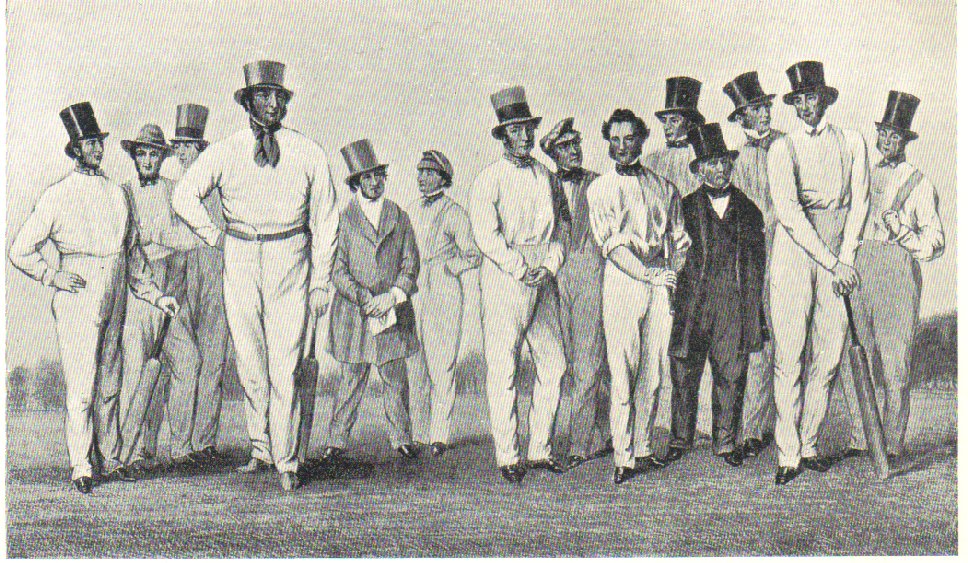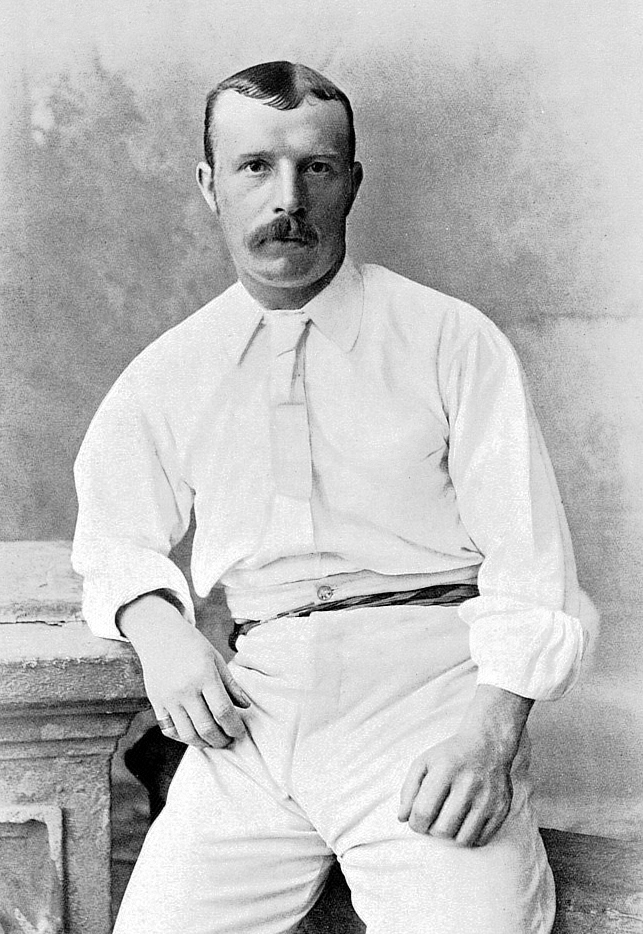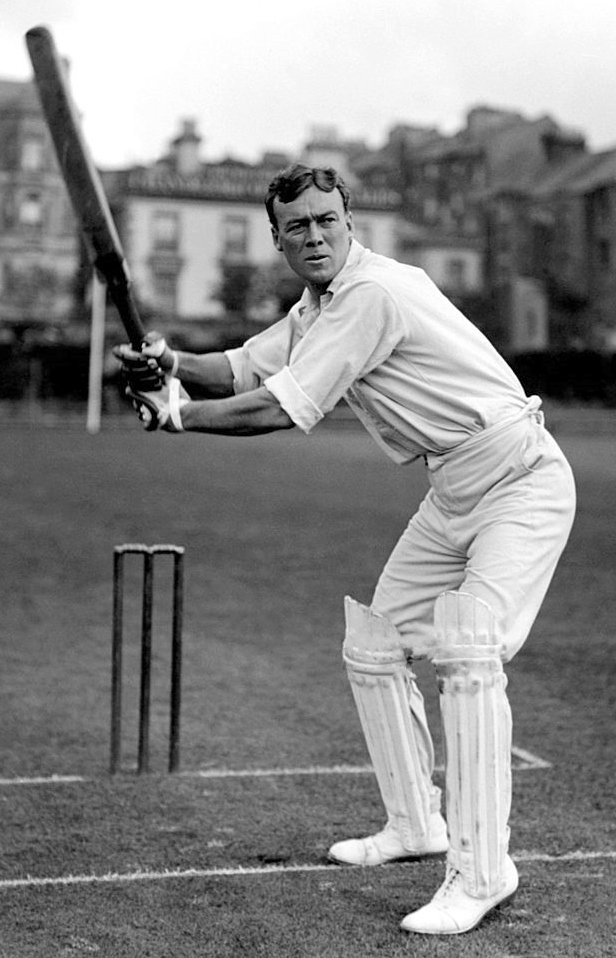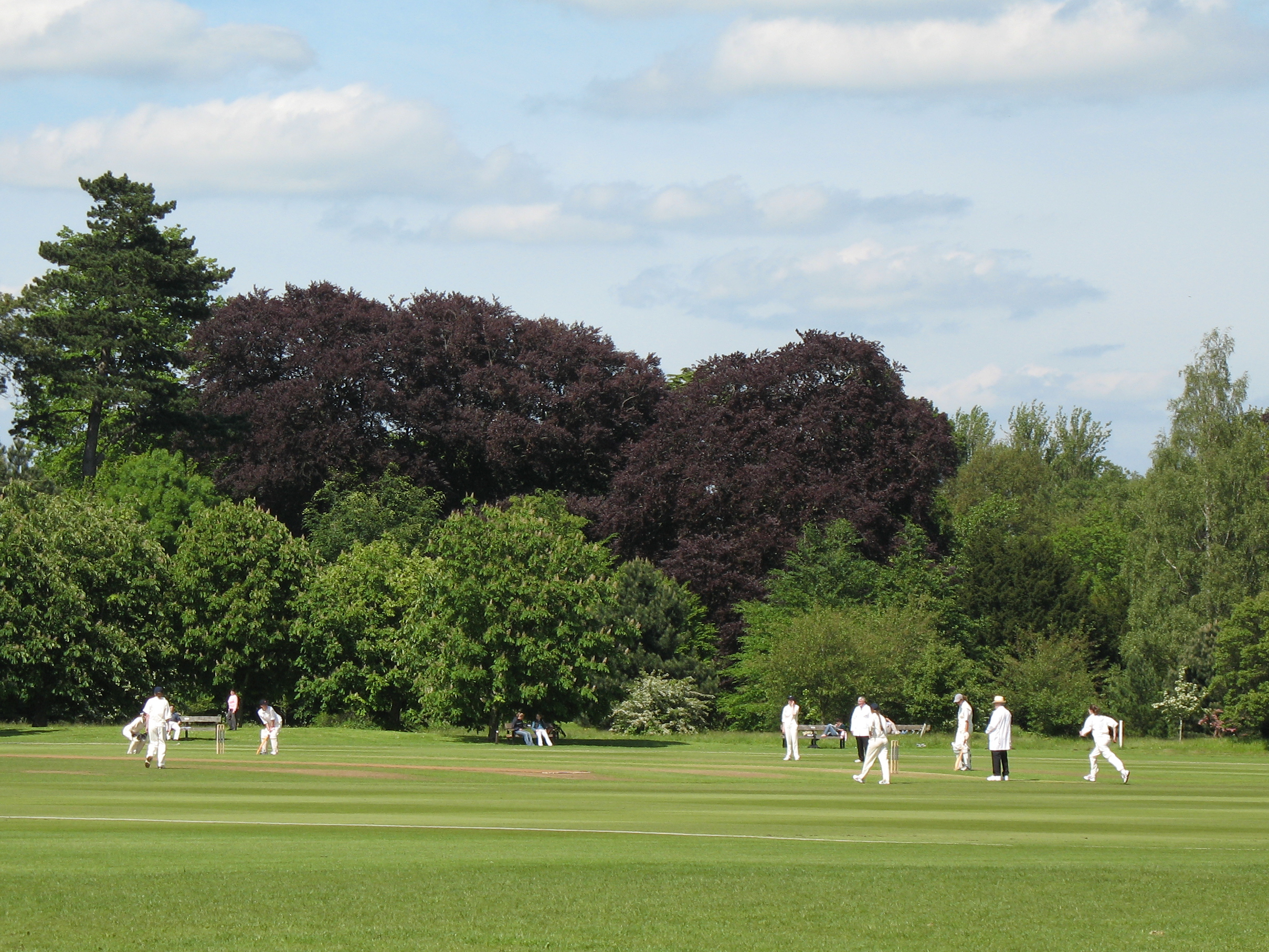|
Frank Mitchell (sportsman Born 1872)
Frank Mitchell (13 August 1872 – 11 October 1935) was an English international cricketer and rugby union player. School, University and Yorkshire Born on 13 August 1872 in Market Weighton, Yorkshire, Mitchell was schooled at St Peter's School in York and captained the school side for two years before moving to Brighton, where he took up employment as a schoolmaster for another two years. This meant that when he went up to Cambridge University, where he was admitted to Caius College, he was older and more experienced than many of his contemporaries, and he swiftly moved into the university side, where he remained from 1894 to 1897. It was as captain of the university side in 1896 that Mitchell instructed his bowler to give away runs so that Oxford University would not be required to follow-on their innings (at the time sides surrendering an 80 run deficit in the first innings were required to follow-on). Protests came from both the Pavilion and in newspapers about this. ... [...More Info...] [...Related Items...] OR: [Wikipedia] [Google] [Baidu] |
Market Weighton
Market Weighton ( ) is a town and civil parish in the East Riding of Yorkshire, England. It is one of the main market towns in the East Yorkshire Wolds and lies midway between Hull and York, about from either one. According to the 2011 UK census, Market Weighton parish had a population of 6,429, an increase on the 2001 UK census figure of 5,212. History The 19th-century English lexicographer Sir William Smith proposed Market Weighton as the location of the still-undiscovered Roman camp of Delgovicia. Historically the town was listed in the ''Domesday Book'' as "Wicstun" and was granted its charter to become a market town in 1251. Notable architecture includes: a parish church, parts of which are Norman, the Londesborough Arms (an 18th-century coaching inn), a Wesleyan chapel, a Methodist chapel and a high street still recognisable from the 19th century. Other sights of interest include the post office, the duck pond and Station Farm. Market Weighton history includes W ... [...More Info...] [...Related Items...] OR: [Wikipedia] [Google] [Baidu] |
Caius College
Gonville and Caius College, often referred to simply as Caius ( ), is a constituent college of the University of Cambridge in Cambridge, England. Founded in 1348, it is the fourth-oldest of the University of Cambridge's 31 colleges and one of the wealthiest. The college has been attended by many students who have gone on to significant accomplishment, including fifteen Nobel Prize winners, the second-highest of any Oxbridge college after Trinity College, Cambridge. The college has long historical associations with the teaching of medicine, especially due to its prominent alumni in the medical profession. It also has globally-recognized and prestigious academic programmes in law, economics, English literature, and history. Famous Gonville and Caius alumni include physicians John Caius (who gave the college the caduceus in its insignia) and William Harvey. Other alumni in the sciences include Francis Crick (joint discoverer of the structure of DNA with James Watson), James Chad ... [...More Info...] [...Related Items...] OR: [Wikipedia] [Google] [Baidu] |
1900 English Cricket Season
1900 was the 11th season of County Championship cricket in England. Yorkshire County Cricket Club, Yorkshire finished the season unbeaten to take the championship title and were the first unbeaten champions since the official competition began in 1890. Defending champions Surrey County Cricket Club, Surrey finished seventh. Lancashire County Cricket Club, Lancashire were second, and the matches between the two top teams both ended in draws; Yorkshire made 230 in the first innings of the first game, compared to Lancashire's 96, but still could not force a victory, and in the second, with a crowd of over 44,000 present over three days at Old Trafford (cricket), Old Trafford, Yorkshire took a lead of seven runs on first innings, but as only two and a half hours of play had been possible on the second day, the game was drawn. Sussex County Cricket Club, Sussex, who finished third with 18 of 24 matches drawn, enjoyed 2,000 runs from Ranjitsinhji for the second season running, as he bet ... [...More Info...] [...Related Items...] OR: [Wikipedia] [Google] [Baidu] |
Second Boer War
The Second Boer War ( af, Tweede Vryheidsoorlog, , 11 October 189931 May 1902), also known as the Boer War, the Anglo–Boer War, or the South African War, was a conflict fought between the British Empire and the two Boer Republics (the South African Republic and the Orange Free State) over the Empire's influence in Southern Africa from 1899 to 1902. Following the discovery of gold deposits in the Boer republics, there was a large influx of "foreigners", mostly British from the Cape Colony. They were not permitted to have a vote, and were regarded as "unwelcome visitors", invaders, and they protested to the British authorities in the Cape. Negotiations failed and, in the opening stages of the war, the Boers launched successful attacks against British outposts before being pushed back by imperial reinforcements. Though the British swiftly occupied the Boer republics, numerous Boers refused to accept defeat and engaged in guerrilla warfare. Eventually, British scorche ... [...More Info...] [...Related Items...] OR: [Wikipedia] [Google] [Baidu] |
Queen's Own Yorkshire Dragoons
The Queen's Own Yorkshire Dragoons was a yeomanry regiment of the British Army in existence from 1794 to 1956. It was formed as a volunteer cavalry force in 1794 during the French Revolutionary Wars. Its volunteer companies played an active role with the Imperial Yeomanry in the Second Boer War, but opportunities for mounted action were much more restricted during the First World War and it was temporarily converted into a cycle unit. It remained a cavalry regiment throughout the interwar years, and was the last horsed unit of the British Army to see action, in the Syria–Lebanon Campaign of 1941, finally mechanising the following year. It served as motorised infantry in the North African and Italian campaigns of the Second World War. In 1956, it merged with the Yorkshire Hussars and the East Riding of Yorkshire Yeomanry to form the Queen's Own Yorkshire Yeomanry. Its lineage is continued today by A (Yorkshire Yeomanry) Squadron, the Queen's Own Yeomanry. French Revolutiona ... [...More Info...] [...Related Items...] OR: [Wikipedia] [Google] [Baidu] |
English Cricket Team
The England cricket team represents England and Wales in international cricket. Since 1997, it has been governed by the England and Wales Cricket Board (ECB), having been previously governed by Marylebone Cricket Club (the MCC) since 1903. England, as a founding nation, is a Full Member of the International Cricket Council (ICC) with Test, One Day International (ODI) and Twenty20 International (T20I) status. Until the 1990s, Scottish and Irish players also played for England as those countries were not yet ICC members in their own right. England and Australia were the first teams to play a Test match (15–19 March 1877), and along with South Africa, these nations formed the Imperial Cricket Conference (the predecessor to today's International Cricket Council) on 15 June 1909. England and Australia also played the first ODI on 5 January 1971. England's first T20I was played on 13 June 2005, once more against Australia. , England have played 1,058 Test matches, winning 387 an ... [...More Info...] [...Related Items...] OR: [Wikipedia] [Google] [Baidu] |
Lord Hawke
Martin Bladen Hawke, 7th Baron Hawke (16 August 1860 – 10 October 1938), generally known as Lord Hawke, was an English amateur cricketer active from 1881 to 1911 who played for Yorkshire and England. He was born in Willingham by Stow, near Gainsborough, Lincolnshire, and died in Edinburgh. He appeared in 633 first-class matches, including five Test matches, as a righthanded batsman, scoring 16,749 runs with a highest score of 166 and held 209 catches. He scored 13 centuries and 69 half-centuries. Since an 1870 inheritance of his father, Hawke was styled ; he inherited the barony on 5 December 1887 on the death of his father, Edward Henry Julius Hawke, Rector of Willingham 1854–1875, after which the family returned to its seat (main home held for a generation or more), Wighill House and Park, near Tadcaster, Yorkshire. Admiral Hawke, the first Baron, was among the few Admirals elevated for his roles during the Seven Years' War: at the Battle of Quiberon Bay, off Nant ... [...More Info...] [...Related Items...] OR: [Wikipedia] [Google] [Baidu] |
South African Cricket Team
The South Africa national cricket team, also known as the Proteas, represents South Africa in men's international cricket and is administered by Cricket South Africa (CSA). South Africa is a full member of the International Cricket Council (ICC), with Test, One-Day International (ODI) and Twenty20 International (T20I) status. Its nickname derives from South Africa's national flower, '' Protea cynaroides'', commonly known as the "King Protea". South Africa entered first-class and international cricket at the same time when they hosted an England cricket team in the 1888–89 season. Initially, the team was no match for Australia or England but, having gained experience and expertise, they were able to field a competitive team by the first decade of the 20th century. The team regularly played against Australia, England and New Zealand through to the 1960s, by which time there was considerable opposition to the country's apartheid policy. The ICC imposed an international ban on ... [...More Info...] [...Related Items...] OR: [Wikipedia] [Google] [Baidu] |
1898-99 South African Cricket Season
This article describes the history of South African cricket from its known beginnings until the end of the First World War in 1918. Test and first-class cricket were both introduced retrospectively to South Africa in the 1888–89 season by the elevation in status of two matches played by an English touring team against a South African national team. At the same time, the Currie Cup was donated by Sir Donald Currie for the domestic championship and this was first contested in the 1889–90 season. Playing standards rose and a number of provincial teams were able to challenge for the championship, including Eastern Province, Griqualand West, Natal, Transvaal and Western Province. South Africa became increasingly involved in international cricket and the national team undertook six overseas tours (five to England and one to Australia) before 1914. Eight teams, seven English and one Australian, toured South Africa during the period. Beginnings European colonisation of southern Af ... [...More Info...] [...Related Items...] OR: [Wikipedia] [Google] [Baidu] |
Innings
An innings is one of the divisions of a cricket match during which one team takes its turn to bat. Innings also means the period in which an individual player bats (acts as either striker or nonstriker). Innings, in cricket, and rounders, is both singular and plural; this contrasts with baseball and softball in which the singular is "inning". Origin The earliest known record of the term concerns a match in August 1730 at Blackheath, Kent between a Kent side and London Cricket Club. The London-based ''St. James Evening Post'' reported: "'Twas thought that the Kentish champions would have lost their honours by being beat at one innings if time had permitted". Usage in cricket An innings is one of the divisions of a match during which one team takes its turn to bat, and is said to be "in to bat". Innings is the subject of Law 13 in the '' Laws of Cricket''. * In a first-class match, there are up to four innings with each team due to bat twice (in practice, this is not alway ... [...More Info...] [...Related Items...] OR: [Wikipedia] [Google] [Baidu] |
Follow-on
In the game of cricket, a team who batted second and scored significantly fewer runs than the team who batted first may be forced to follow-on: to take their second innings immediately after their first. The follow-on can be enforced by the team who batted first, and is intended to reduce the probability of a drawn result, by allowing the second team's second innings to be completed sooner. The follow-on occurs only in those forms of cricket where each team normally bats twice: notably in domestic first class cricket and international Test cricket. In these forms of cricket, a team cannot win a match unless at least three innings have been completed. If fewer than three innings are completed by the scheduled end of play, the result of the match can only be a draw. The decision to enforce the follow-on is made by the captain of the team who batted first, who considers the score, the apparent strength of the two sides, the conditions of weather and the pitch, and the time rema ... [...More Info...] [...Related Items...] OR: [Wikipedia] [Google] [Baidu] |
Oxford University Cricket Club
Oxford University Cricket Club (OUCC), which represents the University of Oxford, has always held first-class status since 1827 when it made its debut in the inaugural University Match between OUCC and Cambridge University Cricket Club (CUCC). It was classified as a List A team in 1973 only. Home fixtures are played at the University Parks slightly northeast of Oxford city centre. History The earliest reference to cricket at Oxford is in 1673. OUCC made its known debut in the inaugural University Match between Oxford and Cambridge played in 1827. In terms of extant clubs being involved, this is the oldest major fixture in the world: i.e., although some inter-county fixtures are much older, none of the current county clubs were founded before 1839 (the oldest known current fixture is Kent ''versus'' Surrey). The Magdalen Ground was used for the University Cricket Club's first match in 1829, and remain in regular use until 1880. Bullingdon Green was used for two matches in 18 ... [...More Info...] [...Related Items...] OR: [Wikipedia] [Google] [Baidu] |






